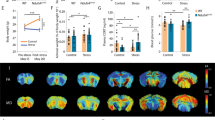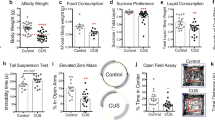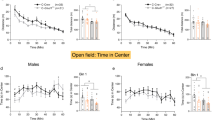Abstract
Genetic susceptibility and environmental factors (such as stress) can interact to affect the likelihood of developing a mood disorder. Stress-induced changes in the hippocampus have been implicated in mood disorders, and mutations in several genes have now been associated with increased risk, such as brain-derived neurotrophic factor (BDNF). The hippocampus has important anatomical subdivisions, and pyramidal neurons of the vulnerable CA3 region show significant remodeling after chronic stress, but the mechanisms underlying their unique plasticity remain unknown. This study characterizes stress-induced changes in the in vivo translating mRNA of this cell population using a CA3-specific enhanced green fluorescent protein (EGFP) reporter fused to the L10a large ribosomal subunit (EGFPL10a). RNA-sequencing after isolation of polysome-bound mRNAs allows for cell-type-specific, genome-wide characterization of translational changes after stress. The data demonstrate that acute and chronic stress produce unique translational profiles and that the stress history of the animal can alter future reactivity of CA3 neurons. CA3-specific EGFPL10a mice were then crossed to the stress-susceptible BDNF Val66Met mouse line to characterize how a known genetic susceptibility alters both baseline translational profiles and the reactivity of CA3 neurons to stress. Not only do Met allele carriers exhibit distinct levels of baseline translation in genes implicated in ion channel function and cytoskeletal regulation, but they also activate a stress response profile that is highly dissimilar from wild-type mice. Closer examination of genes implicated in the mechanisms of neuroplasticity, such as the NMDA and AMPA subunits and the BDNF pathway, reveal how wild-type mice upregulate many of these genes in response to stress, but Met allele carriers fail to do so. These profiles provide a roadmap of stress-induced changes in a genetically homogenous population of hippocampal neurons and illustrate the profound effects of gene–environment interactions on the translational profile of these cells.
This is a preview of subscription content, access via your institution
Access options
Subscribe to this journal
Receive 12 print issues and online access
$259.00 per year
only $21.58 per issue
Buy this article
- Purchase on Springer Link
- Instant access to full article PDF
Prices may be subject to local taxes which are calculated during checkout




Similar content being viewed by others
References
Drevets WC, Price JL, Furey ML . Brain structural and functional abnormalities in mood disorders: implications for neurocircuitry models of depression. Brain Struct Funct 2008; 213: 93–118.
Conrad CD, Galea LA, Kuroda Y, McEwen BS . Chronic stress impairs rat spatial memory on the Y maze, and this effect is blocked by tianeptine pretreatment. Behav Neurosci 1996; 110: 1321–1334.
Krishnan V, Nestler EJ . Animal models of depression: molecular perspectives. Curr Top Behav Neurosci 2011; 7: 121–147.
McEwen BS . Stress and hippocampal plasticity. Annu Rev Neurosci 1999; 22: 105–122.
Gilbert PE, Brushfield AM . The role of the CA3 hippocampal subregion in spatial memory: a process oriented behavioral assessment. Prog Neuropsychopharmacol Biol Psychiatry 2009; 33: 774–781.
Woolley CS, Gould E, McEwen BS . Exposure to excess glucocorticoids alters dendritic morphology of adult hippocampal pyramidal neurons. Brain Res 1990; 531: 225–231.
Watanabe Y, Gould E, McEwen BS . Stress induces atrophy of apical dendrites of hippocampal CA3 pyramidal neurons. Brain Res 1992; 588: 341–345.
Chen Y, Dube CM, Rice CJ, Baram TZ . Rapid loss of dendritic spines after stress involves derangement of spine dynamics by corticotropin-releasing hormone. J Neurosci 2008; 28: 2903–2911.
Kim JJ, Diamond DM . The stressed hippocampus, synaptic plasticity and lost memories. Nat Rev Neurosci 2002; 3: 453–462.
Popoli M, Yan Z, McEwen BS, Sanacora G . The stressed synapse: the impact of stress and glucocorticoids on glutamate transmission. Nat Rev Neurosci 2012; 13: 22–37.
Duman RS, Monteggia LM . A neurotrophic model for stress-related mood disorders. Biol Psychiatry 2006; 59: 1116–1127.
Nibuya M, Morinobu S, Duman RS . Regulation of BDNF and trkB mRNA in rat brain by chronic electroconvulsive seizure and antidepressant drug treatments. J Neurosci 1995; 15: 7539–7547.
Magarinos AM, Li CJ, Gal Toth J, Bath KG, Jing D, Lee FS et al. Effect of brain-derived neurotrophic factor haploinsufficiency on stress-induced remodeling of hippocampal neurons. Hippocampus 2011; 21: 253–264.
Sen S, Nesse RM, Stoltenberg SF, Li S, Gleiberman L, Chakravarti A et al. A BDNF coding variant is associated with the NEO personality inventory domain neuroticism, a risk factor for depression. Neuropsychopharmacology 2003; 28: 397–401.
Verhagen M, van der Meij A, van Deurzen PA, Janzing JG, Arias-Vasquez A, Buitelaar JK et al. Meta-analysis of the BDNF Val66Met polymorphism in major depressive disorder: effects of gender and ethnicity. Mol Psychiatry 2010; 15: 260–271.
Egan MF, Kojima M, Callicott JH, Goldberg TE, Kolachana BS, Bertolino A et al. The BDNF val66met polymorphism affects activity-dependent secretion of BDNF and human memory and hippocampal function. Cell 2003; 112: 257–269.
Elzinga BM, Molendijk ML, Oude Voshaar RC, Bus BA, Prickaerts J, Spinhoven P et al. The impact of childhood abuse and recent stress on serum brain-derived neurotrophic factor and the moderating role of BDNF Val66Met. Psychopharmacology (Berl) 2011; 214: 319–328.
Gatt JM, Nemeroff CB, Dobson-Stone C, Paul RH, Bryant RA, Schofield PR et al. Interactions between BDNF Val66Met polymorphism and early life stress predict brain and arousal pathways to syndromal depression and anxiety. Mol Psychiatry 2009; 14: 681–695.
Chen ZY, Jing D, Bath KG, Ieraci A, Khan T, Siao CJ et al. Genetic variant BDNF (Val66Met) polymorphism alters anxiety-related behavior. Science 2006; 314: 140–143.
Yu H, Wang DD, Wang Y, Liu T, Lee FS, Chen ZY . Variant brain-derived neurotrophic factor Val66Met polymorphism alters vulnerability to stress and response to antidepressants. J Neurosci 2012; 32: 4092–4101.
Gray JD, Rubin TG, Hunter RG, McEwen BS . Hippocampal gene expression changes underlying stress sensitization and recovery. Mol Psychiatry 2014; 19: 1171–1178.
Liu Y, Yang N, Zuo P . cDNA microarray analysis of gene expression in the cerebral cortex and hippocampus of BALB/c mice subjected to chronic mild stress. Cell Mol Neurobiol 2010; 30: 1035–1047.
Ejchel-Cohen TF, Wood GE, Wang JF, Barlow K, Nobrega JN, McEwen BS et al. Chronic restraint stress decreases the expression of glutathione S-transferase pi2 in the mouse hippocampus. Brain Res 2006; 1090: 156–162.
Wang DD, Tian T, Dong Q, Xu XF, Yu H, Wang Y et al. Transcriptome profiling analysis of the mechanisms underlying the BDNF Val66Met polymorphism induced dysfunctions of the central nervous system. Hippocampus 2014; 24: 65–78.
McEwen BS . Stress-induced remodeling of hippocampal CA3 pyramidal neurons. Brain Res 2016; 1645: 50–54.
Heiman M, Schaefer A, Gong S, Peterson JD, Day M, Ramsey KE et al. A translational profiling approach for the molecular characterization of CNS cell types. Cell 2008; 135: 738–748.
Heiman M, Kulicke R, Fenster RJ, Greengard P, Heintz N . Cell type-specific mRNA purification by translating ribosome affinity purification (TRAP). Nat Protoc 2014; 9: 1282–1291.
Kim D, Pertea G, Trapnell C, Pimentel H, Kelley R, Salzberg SL . TopHat2: accurate alignment of transcriptomes in the presence of insertions, deletions and gene fusions. Genome Biol 2013; 14: R36.
Anders S, Huber W . Differential expression analysis for sequence count data. Genome Biol 2010; 11: R106.
Huang, da W, Sherman BT, Lempicki RA . Systematic and integrative analysis of large gene lists using DAVID bioinformatics resources. Nat Protoc 2009; 4: 44–57.
Huang, da W, Sherman BT, Lempicki RA . Bioinformatics enrichment tools: paths toward the comprehensive functional analysis of large gene lists. Nucleic Acids Res 2009; 37: 1–13.
Livak KJ, Schmittgen TD . Analysis of relative gene expression data using real-time quantitative PCR and the 2(-Delta Delta C(T)) Method. Methods 2001; 25: 402–408.
Doyle JP, Dougherty JD, Heiman M, Schmidt EF, Stevens TR, Ma G et al. Application of a translational profiling approach for the comparative analysis of CNS cell types. Cell 2008; 135: 749–762.
Schmidt EF, Warner-Schmidt JL, Otopalik BG, Pickett SB, Greengard P, Heintz N . Identification of the cortical neurons that mediate antidepressant responses. Cell 2012; 149: 1152–1163.
Ainsley JA, Drane L, Jacobs J, Kittelberger KA, Reijmers LG . Functionally diverse dendritic mRNAs rapidly associate with ribosomes following a novel experience. Nat Commun 2014; 5: 4510.
Zhao S, Fung-Leung WP, Bittner A, Ngo K, Liu X . Comparison of RNA-Seq and microarray in transcriptome profiling of activated T cells. PLoS One 2014; 9: e78644.
Nookaew I, Papini M, Pornputtapong N, Scalcinati G, Fagerberg L, Uhlen M et al. A comprehensive comparison of RNA-Seq-based transcriptome analysis from reads to differential gene expression and cross-comparison with microarrays: a case study in Saccharomyces cerevisiae. Nucleic Acids Res 2012; 40: 10084–10097.
de Kloet ER, Molendijk ML . Coping with the forced swim stressor: towards understanding an adaptive mechanism. Neural Plast 2016; 2016: 6503162.
Polman JA, de Kloet ER, Datson NA . Two populations of glucocorticoid receptor-binding sites in the male rat hippocampal genome. Endocrinology 2013; 154: 1832–1844.
Harris AP, Holmes MC, de Kloet ER, Chapman KE, Seckl JR . Mineralocorticoid and glucocorticoid receptor balance in control of HPA axis and behaviour. Psychoneuroendocrinology 2013; 38: 648–658.
Binder EB . The role of FKBP5, a co-chaperone of the glucocorticoid receptor in the pathogenesis and therapy of affective and anxiety disorders. Psychoneuroendocrinology 2009; 34 (Suppl 1): S186–S195.
Kullmann M, Schneikert J, Moll J, Heck S, Zeiner M, Gehring U et al. RAP46 is a negative regulator of glucocorticoid receptor action and hormone-induced apoptosis. J Biol Chem 1998; 273: 14620–14625.
Marmigere F, Givalois L, Rage F, Arancibia S, Tapia-Arancibia L . Rapid induction of BDNF expression in the hippocampus during immobilization stress challenge in adult rats. Hippocampus 2003; 13: 646–655.
Smith MA, Makino S, Kvetnansky R, Post RM . Stress and glucocorticoids affect the expression of brain-derived neurotrophic factor and neurotrophin-3 mRNAs in the hippocampus. J Neurosci 1995; 15 (3 Pt 1): 1768–1777.
Mallei A, Baj G, Ieraci A, Corna S, Musazzi L, Lee FS et al. Expression and dendritic trafficking of BDNF-6 splice variant are impaired in knock-in mice carrying human BDNF Val66Met polymorphism. Int J Neuropsychopharmacol 2015; 18: 12.
Lambert WM, Xu CF, Neubert TA, Chao MV, Garabedian MJ, Jeanneteau FD . Brain-derived neurotrophic factor signaling rewrites the glucocorticoid transcriptome via glucocorticoid receptor phosphorylation. Mol Cell Biol 2013; 33: 3700–3714.
Spruston N, Jonas P, Sakmann B . Dendritic glutamate receptor channels in rat hippocampal CA3 and CA1 pyramidal neurons. J Physiol 1995; 482: 325–352.
Bartanusz V, Aubry JM, Pagliusi S, Jezova D, Baffi J, Kiss JZ . Stress-induced changes in messenger RNA levels of N-methyl-D-aspartate and AMPA receptor subunits in selected regions of the rat hippocampus and hypothalamus. Neuroscience 1995; 66: 247–252.
Lu W, Man H, Ju W, Trimble WS, MacDonald JF, Wang YT . Activation of synaptic NMDA receptors induces membrane insertion of new AMPA receptors and LTP in cultured hippocampal neurons. Neuron 2001; 29: 243–254.
Ninan I, Bath KG, Dagar K, Perez-Castro R, Plummer MR, Lee FS et al. The BDNF Val66Met polymorphism impairs NMDA receptor-dependent synaptic plasticity in the hippocampus. J Neurosci 2010; 30: 8866–8870.
Korte M, Carroll P, Wolf E, Brem G, Thoenen H, Bonhoeffer T . Hippocampal long-term potentiation is impaired in mice lacking brain-derived neurotrophic factor. Proc Natl Acad Sci USA 1995; 92: 8856–8860.
Ying SW, Futter M, Rosenblum K, Webber MJ, Hunt SP, Bliss TV et al. Brain-derived neurotrophic factor induces long-term potentiation in intact adult hippocampus: requirement for ERK activation coupled to CREB and upregulation of Arc synthesis. J Neurosci 2002; 22: 1532–1540.
Deinhardt K, Kim T, Spellman DS, Mains RE, Eipper BA, Neubert TA et al. Neuronal growth cone retraction relies on proneurotrophin receptor signaling through Rac. Sci Signal 2011; 4: ra82.
Anastasia A, Deinhardt K, Chao MV, Will NE, Irmady K, Lee FS et al. Val66Met polymorphism of BDNF alters prodomain structure to induce neuronal growth cone retraction. Nat Commun 2013; 4: 2490.
de Almeida L, Idiart M, Lisman JE . Memory retrieval time and memory capacity of the CA3 network: role of gamma frequency oscillations. Learn Mem 2007; 14: 795–806.
Datson NA, van den Oever JM, Korobko OB, Magarinos AM, de Kloet ER, McEwen BS . Previous history of chronic stress changes the transcriptional response to glucocorticoid challenge in the dentate gyrus region of the male rat hippocampus. Endocrinology 2013; 154: 3261–3272.
Wang Z, Gerstein M, Snyder M . RNA-Seq: a revolutionary tool for transcriptomics. Nat Rev Genet 2009; 10: 57–63.
Isgor C, Kabbaj M, Akil H, Watson SJ . Delayed effects of chronic variable stress during peripubertal-juvenile period on hippocampal morphology and on cognitive and stress axis functions in rats. Hippocampus 2004; 14: 636–648.
Kuroda Y, McEwen BS . Effect of chronic restraint stress and tianeptine on growth factors, growth-associated protein-43 and microtubule-associated protein 2 mRNA expression in the rat hippocampus. Brain Res Mol Brain Res 1998; 59: 35–39.
Gray JD, Milner TA, McEwen BS . Dynamic plasticity: the role of glucocorticoids, brain-derived neurotrophic factor and other trophic factors. Neuroscience 2013; 239: 214–227.
Chiaruttini C, Vicario A, Li Z, Baj G, Braiuca P, Wu Y et al. Dendritic trafficking of BDNF mRNA is mediated by translin and blocked by the G196A (Val66Met) mutation. Proc Natl Acad Sci U S A 2009; 106: 16481–16486.
Leal G, Comprido D, Duarte CB . BDNF-induced local protein synthesis and synaptic plasticity. Neuropharmacology 2014; 76: 639–656.
Simsek-Duran F, Lonart G . The role of RIM1alpha in BDNF-enhanced glutamate release. Neuropharmacology 2008; 55: 27–34.
Caldeira MV, Melo CV, Pereira DB, Carvalho RF, Carvalho AL, Duarte CB . BDNF regulates the expression and traffic of NMDA receptors in cultured hippocampal neurons. Mol Cell Neurosci 2007; 35: 208–219.
Caldeira MV, Melo CV, Pereira DB, Carvalho R, Correia SS, Backos DS et al. Brain-derived neurotrophic factor regulates the expression and synaptic delivery of alpha-amino-3-hydroxy-5-methyl-4-isoxazole propionic acid receptor subunits in hippocampal neurons. J Biol Chem 2007; 282: 12619–12628.
Arango-Lievano M, Lambert WM, Bath KG, Garabedian MJ, Chao MV, Jeanneteau F . Neurotrophic-priming of glucocorticoid receptor signaling is essential for neuronal plasticity to stress and antidepressant treatment. Proc Natl Acad Sci USA 2015; 112: 15737–15742.
Weiland NG, Orchinik M, Tanapat P . Chronic corticosterone treatment induces parallel changes in N-methyl-D-aspartate receptor subunit messenger RNA levels and antagonist binding sites in the hippocampus. Neuroscience 1997; 78: 653–662.
Schwendt M, Jezova D . Gene expression of two glutamate receptor subunits in response to repeated stress exposure in rat hippocampus. Cell Mol Neurobiol 2000; 20: 319–329.
Calabrese F, Guidotti G, Molteni R, Racagni G, Mancini M, Riva MA . Stress-induced changes of hippocampal NMDA receptors: modulation by duloxetine treatment. PLoS One 2012; 7: e37916.
Acknowledgements
This project was supported by NIH/F32 MH102065 to JDG, NIH/RO1 MH41256 and the Hope for Depression Research Foundation grant RGA#13-004 to BSM, the Pritzker Consortium and NIH/ R01 NS052819 to FSL, and Brain & Behavior Research Foundation NARSAD Young Investigator Grant 21464, the van Ameringen Foundation and NIH/NINDS R01NS091722 to EFS.
Author information
Authors and Affiliations
Corresponding author
Ethics declarations
Competing interests
The authors declare no conflict of interest.
Additional information
Supplementary Information accompanies the paper on the Molecular Psychiatry website
Rights and permissions
About this article
Cite this article
Gray, J., Rubin, T., Kogan, J. et al. Translational profiling of stress-induced neuroplasticity in the CA3 pyramidal neurons of BDNF Val66Met mice. Mol Psychiatry 23, 904–913 (2018). https://doi.org/10.1038/mp.2016.219
Received:
Revised:
Accepted:
Published:
Issue Date:
DOI: https://doi.org/10.1038/mp.2016.219
This article is cited by
-
Corticosterone induces discrete epigenetic signatures in the dorsal and ventral hippocampus that depend upon sex and genotype: focus on methylated Nr3c1 gene
Translational Psychiatry (2022)
-
Genomic modules and intramodular network concordance in susceptible and resilient male mice across models of stress
Neuropsychopharmacology (2022)
-
Multiomic profiling of the acute stress response in the mouse hippocampus
Nature Communications (2022)
-
Neurotrophic factor-α1, a novel tropin is critical for the prevention of stress-induced hippocampal CA3 cell death and cognitive dysfunction in mice: comparison to BDNF
Translational Psychiatry (2021)
-
Shisa6 mediates cell-type specific regulation of depression in the nucleus accumbens
Molecular Psychiatry (2021)



